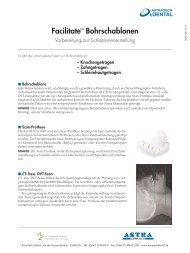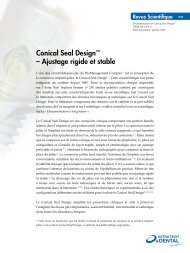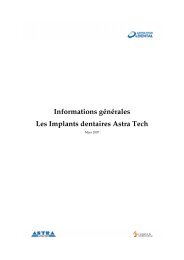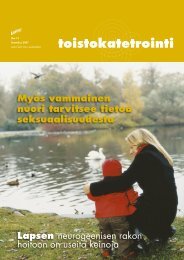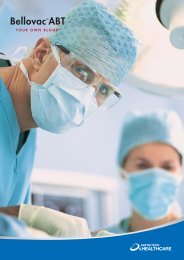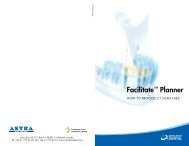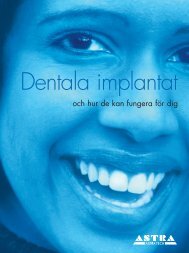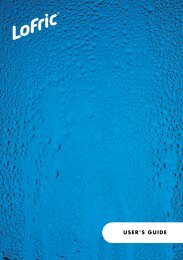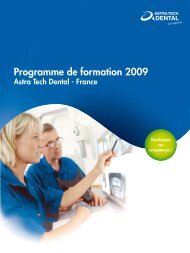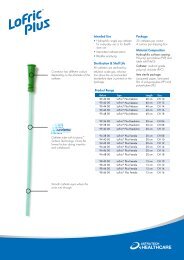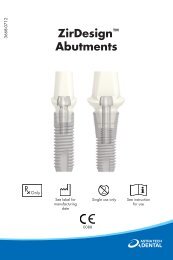Create successful ePaper yourself
Turn your PDF publications into a flip-book with our unique Google optimized e-Paper software.
Background<strong>Dental</strong> <strong>Implants</strong> <strong>and</strong> <strong>Astra</strong> <strong>Tech</strong>September 20081/7
CONTENTSTooth loss: A common problem.................................................................………… 3Traditional solutions.....................................................................................………… 3<strong>Dental</strong> implants ........................................................................................................... 4Market trends .................................................................................................……….. 4<strong>Astra</strong> <strong>Tech</strong> acquires leading company of CAD/CAM technology.......………... 5<strong>Astra</strong> <strong>Tech</strong> Implant System ......................................................................………... 6Focus on education ........................................................................................……….. 6<strong>Astra</strong> <strong>Tech</strong> in brief...........................................................................................……….. 7Contact information .......................................................................................……….. 72/7
Tooth loss: a common problemTooth loss affects many people. Between 6% <strong>and</strong> 10% of the populations of NorthAmerica, Japan <strong>and</strong> Europe have no teeth in either their upper or lower jaw.More than 240 million people in these parts of the world are missing one or more teeth.Some five million (2%) have dental implants, while 50 million have traditional bridges orfalse teeth. The majority of more than 180 million people receive no treatment at all <strong>and</strong>they simply live with one or more gaps in their mouth.Retirees are the largest, most rapidly growing age group in need of tooth restorations.According to the World Health Organization, 29% of the population in the U.S., 50% inAustralia <strong>and</strong> 20% in Japan above the age of 65 have no natural teeth.In Europe, the percentage of people over 65 years old who are missing all their teeth,varies considerably. Sweden (13%) <strong>and</strong> Switzerl<strong>and</strong> (12%) are in relatively good shape,Germany (25%) does not fare quite as well, while the UK (57%) <strong>and</strong> the Netherl<strong>and</strong>s(65%) fare much worse.Traditional solutionsThe average life expectancy is generally increasing <strong>and</strong> older people represent a growingpercentage of the population. The dem<strong>and</strong> for functional, attractive teeth at all stages oflife has also grown in recent years. Many older people lead active lifestyles <strong>and</strong> are nowunwilling to accept traditional solutions, such as bridges <strong>and</strong> dentures, that mayadversely affect their overall appearance <strong>and</strong> leave them with less than ideal chewingfunction. Younger people who have lost one or more teeth are eager for solutions thatfeel like real teeth <strong>and</strong> that will last for the rest of their lives.A traditional bridge requires the dentist to grind down adjacent teeth so that there is asupport to which the bridge can be fastened. However, supporting teeth can decay<strong>and</strong>/or loosen over time requiring the need for new bridges.When all the teeth in either the upper <strong>and</strong> lower jaw are gone, dentures represent onetreatment option. But because traditional dentures do not help stimulate <strong>and</strong> maintainthe jaw bone, the bone continues to resorb over time, leading to loose <strong>and</strong> ill-fittingdentures that often cause irritation to the gums <strong>and</strong> slurred speech. As a result, acommon outcome is a deterioration in quality of life due to embarrassment <strong>and</strong>discomfort.3/7
<strong>Dental</strong> implantsThe field of dental implants is evolving rapidly. New technologies <strong>and</strong> improvements inbiocompatible materials have enabled the development of systems that ensure fasterhealing, more reliable results <strong>and</strong> an esthetic outcome.<strong>Dental</strong> implants first appeared back in the mid-1960s when Swedish professorPer-Ingvar Brånemark discovered that the body accepted titanium <strong>and</strong> could integrate itwith existing bone tissue. This made it possible to place dental implants in the jawboneso that new teeth could be attached to them in a way that resembles nature. <strong>Implants</strong> cannow be used to replace missing teeth in all situations from a single tooth to the entire setof teeth in both jaws. In other words, patients have access to dental solutions that look,feel <strong>and</strong> function like natural teeth. They can chew <strong>and</strong> smile as usual.The first part of the treatment involves a surgical procedure during which the implant, asmall titanium screw, is installed in the jawbone. The implant serves as a root <strong>and</strong> isintegrated as new bone mass forms in contact with the surface of the titanium. Atitanium or ceramic abutment is fastened to the implant. A crown, the visible part of thereconstructed tooth, is then placed on the abutment. When multiple teeth are to bereplaced, two or more implants are installed to build the foundation for a fixed implantbridge reconstruction.The current trend is moving toward shorter treatment periods <strong>and</strong> earlier loading of theimplant. Depending on the patient’s condition <strong>and</strong> choice of treatment, the process canrange from immediate loading to a treatment period of several months. The patientreceives temporary tooth replacement during the treatment period.Market trendsGrowing dem<strong>and</strong> for attractive, functional tooth replacement has created a largepotential market. With approximately 8-10% annual growth, dental implants are anexp<strong>and</strong>ing segment of the global medical devices sector.The trend in the industry is also moving toward fewer <strong>and</strong> larger international firms.The first wave of consolidation took place some five years ago. Today, six or sevencompanies spearhead developments <strong>and</strong> about 100 smaller businesses operate withinvarious niches of the market.4/7
<strong>Astra</strong> <strong>Tech</strong> acquires leading company of CAD/CAMtechnologyAs part of <strong>Astra</strong> <strong>Tech</strong>’s growth strategy, the US company Atlantis Components, Inc. wasacquired by <strong>Astra</strong> <strong>Tech</strong> in September, 2007. The acquisition of Atlantis gives <strong>Astra</strong> <strong>Tech</strong>access to advanced know-how <strong>and</strong> the latest CAD/CAM technology for patient-specificabutments based on each patient’s individual needs. An abutment acts as the linkbetween the implant <strong>and</strong> the crown (the visible part of the replacement tooth).When an abutment is produced using Atlantis’ patented method, the appearance of thecompleted tooth is used as the basis for fabrication. The dentist takes an impression thatis scanned into a software program where the new tooth is then designed.Production of abutments is done in computerized milling machines controlled by CNC(Computer Numerical Control). This control system makes it possible to producecomplicated, individually adapted components in an efficient manner. The abutmentscan be made of titanium or zirconium. Zirconium is a ceramic material that is usedprimarily for restoring front teeth where dem<strong>and</strong>s for esthetics are particularly high.Atlantis’ abutments can be used together with most major implant systems available onthe market. In the future, it will also be possible to use digital technology for producingcrowns <strong>and</strong> bridges.Atlantis’ method in combination with <strong>Astra</strong> <strong>Tech</strong> Implant System ensures an optimalconnection of the abutment to the soft tissue making it possible to achieve ideal esthetics<strong>and</strong> stability. The precision of the patient-specific abutments helps eliminate the need fordentists to make additional modifications to the abutment, allowing for reduced chairtime. The digital process also provides simplified procedures <strong>and</strong> increased profitabilityfor the dental laboratories.Atlantis’ abutments are manufactured in Cambridge, Massachusetts, USA near<strong>Astra</strong> <strong>Tech</strong>’s North American subsidiary headquartered in Waltham, Massachusetts. ACenter of Excellence for esthetics will be established, based on the Atlantis technology.Atlantis’ abutments for the European market are now produced at <strong>Astra</strong> <strong>Tech</strong>’sheadquarters in Mölndal, Sweden.5/7
<strong>Astra</strong> <strong>Tech</strong> Implant System<strong>Astra</strong> <strong>Tech</strong> is a leader in the areas of dental implant R&D. <strong>Astra</strong> <strong>Tech</strong> Implant Systemis backed by over 20 years of scientific documentation making it the most welldocumentedsystem in the world.The most recent innovation, the world’s first <strong>and</strong> only, fluoride-modified titaniumimplant surface, OsseoSpeed, is now available in Europe <strong>and</strong> the United States. Thefluoride-modified surface, with its unique nano-structure, promotes more rapid bonehealing that leads to more reliable treatment results.<strong>Astra</strong> <strong>Tech</strong>’s R&D is based on a holistic view in which a system of products <strong>and</strong> methodsinteract. A number of international studies are currently being conducted on the<strong>Astra</strong> <strong>Tech</strong> Implant System. The most recent findings show that OsseoSpeed has a highsuccess rate even in difficult cases. This opens the door to implant treatment for patientswho have porous or insufficient jawbone. The short-term focus of clinical research is toevaluate studies that look at OsseoSpeed’s effect on specific risk groups, such as patientssuffering from osteoporosis.<strong>Astra</strong> <strong>Tech</strong>’s clinical studies are conducted in collaboration with universities all over theworld. The studies are linked to independent advisory boards in order to ensureobjectivity <strong>and</strong> the highest ethical st<strong>and</strong>ards. At present, some 250 dentists are involvedin the clinical studies <strong>and</strong> evaluations, which include over 800 patients in Europe, theUnited States, <strong>and</strong> other parts of the world.Focus on educationEducation is an important part of <strong>Astra</strong> <strong>Tech</strong>’s operations in their efforts to help dentalprofessionals provide best possible quality of treatment for their patients. <strong>Astra</strong> <strong>Tech</strong> hasprovided implant training for tens of thous<strong>and</strong>s of dentists, <strong>and</strong> that number is steadilyincreasing. New programs are continually added to keep pace with developments inimplant systems <strong>and</strong> treatment methods.The most recent development within the area of education was the official opening in2007 of the new, international training center at <strong>Astra</strong> <strong>Tech</strong>’s headquarters in Mölndal,Sweden. The company has invested SEK 220 million in the new center for research <strong>and</strong>education <strong>and</strong> it is one of the most advanced facilities of its kind in the world. Dentistsfrom many countries will be given the opportunity to come to the center to learnadvanced implant techniques.<strong>Astra</strong> <strong>Tech</strong> has on-going collaboration with a number of universities <strong>and</strong> universityhospitals, such as Gothenburg University, Uppsala University Hospital (both inSweden), the University of Iowa, <strong>and</strong> the University of North Carolina (both in USA).The collaborative efforts with these universities encompass both R&D <strong>and</strong> training.6/7
<strong>Astra</strong> <strong>Tech</strong> in brief<strong>Astra</strong> <strong>Tech</strong> is a medical technology company that develops, manufactures <strong>and</strong> sellsdental implants <strong>and</strong> other leading-edge healthcare products, chiefly in the fields ofurology, odontology <strong>and</strong> surgery.<strong>Astra</strong> <strong>Tech</strong>, a subsidiary of the pharmaceutical company <strong>Astra</strong>Zeneca, has itsheadquarters in Mölndal, Sweden, where there are facilities for research <strong>and</strong>development, as well as production. The company has subsidiaries in 16 countries inEurope, North America <strong>and</strong> Asia/Pacific <strong>and</strong> is represented by local partners in otherselected markets.<strong>Astra</strong> <strong>Tech</strong> has approximately 2 100 employees <strong>and</strong> a posted revenue of SEK 3 billion in2007.The most important dental markets are the United States <strong>and</strong> Germany, where<strong>Astra</strong> <strong>Tech</strong> also has its strongest growth.Contact informationFor additional information, please contact:Björn Delin, Business Unit Director, <strong>Dental</strong>, <strong>Astra</strong> <strong>Tech</strong> AB,phone +46 705 76 72 60Kerstin Wettby, Head of Market Communication, <strong>Dental</strong>, <strong>Astra</strong> <strong>Tech</strong> AB,phone +46 705 16 32 02Headquarters: <strong>Astra</strong> <strong>Tech</strong> AB, P. O. Box 14, 431 21 Mölndal, Sweden,phone (switchboard): +46 31 776 30 00See also www.astratechdental.com7/7



